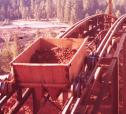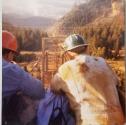
| Home | Open Account | Help | 401 users online |
|
Member Login
Discussion
Media SharingHostingLibrarySite Info |
Nostalgia & History > New Life for old nickel mine in OregonDate: 08/13/13 20:31 New Life for old nickel mine in Oregon Author: TonyJ I was going through some photos and updating information for one of our NRHS chapter's photo-storyboards inside our museum at the Medford Railroad Park when I thought I'd post some of it here on Trainorders. It's a brief history about the only nickel mine in the United States, and the short spur that connected it to the SP Siskiyou Line and the outside world.. - Tony J.
Glenbrook Nickel Company Siskiyou Line - Southern Pacific milepost 540.3 – Cornutt, Oregon The short line is only about 1.5 miles in length, but hauled one hundred percent of the nickel smelted in the United States. Nickel ore was discovered Nickel Mountain in 1865 by sheep herders. A mine was not opened until 1891 and not mined commercially until 1954. After the Korean Was the Federal government became acutely aware that the US had no domestic production of nickel. In 1954 or so, the U.S. Government made a decision that this country needed an integrated nickel mine and smelter to produce Ferro nickel. That product was considered strategic for the defense of the country because it was used in the construction of fighter airplanes. A few of nickel’s uses is used to harden iron to make steel and to make stainless steel. It just so happened that the Secretary of the Treasury was also the Chairman, on leave to serve for President Eisenhower, of the Hanna Mining Co. A deal was struck that the U.S. Government would develop and build this operation and M. A. Hanna would operate it for a fee and an additional incentive. The incentive was that for each pound of Ferro Nickel produced, Hanna would earn ownership. By the 1970s, Hanna owned this operation and Ferro nickel was sold on the open market. Note that in about 1966 the congress began to doubt the legality of the deal and congressional hearings followed. It is very interesting reading because Mr. Humphrey, the chairman, later testified before congress. His testimony is considered one of the best persuasive arguments ever presented in congressional hearings. Where to mine this nickel? Just west of Riddle, Oregon, in the Coast Range, is a place called Nickel Mountain. The nickel ore there was only 1.5% nickel compared to up to 25% nickel at foreign mines, but the feds wanted domestic nickel production, so the US government subsidized the formation and operation of the Hanna Nickel Mining Co. which mined the ore and smelted it on site. The plant and mined employed about 700 people in the early days and provided much needed income to an area with shrinking timber revenue. Although Nickel Mountain is not in the middle of nowhere, the steepness of Nickel Mountain made hauling the nickel ore down to the smelter was a bit of challenge. In the winter it would rain everyday. When the temperatures dropped that would mean a great deal of snow on the mountain. Compared to many open pit operations, Hanna Nickel used small shovels and trucks. The 75-ton trucks and the shovels were not very large compared to other iron ore operations and coal operations. The ore content was about 1% nickel and there were truck mounted analysis labs that tested the ore content of what was being mined. If "higher" grade ore was found in a pocket it was mixed with lower grade ore to allow a consistent product to be sent to the smelting operation at the bottom of the hill. High atop the mountain the process of getting the mined ore to the plant started here. Due to the distance from the plant below, there was an office, change facility, lunch room, maintenance shop, and warehouse located at the top. Semi trucks making deliveries had to climb up a very winding and steep road to the top. The return trip was a test of their air brakes. At the top of Nickel Mountain a means of transferring the nickel ore 5,000 feet horizontally and about 7,000 feet in elevation had to be constructed. For many reasons, including the weather, an aerial tramway was constructed. The tram cars were suspended on cables than ran on a continuous loop. The cars being upright going down, turning upside down to dump the 2,000 lbs of ore inside and returning upside down to the top of the hill. The weight of the filled cars caused the tram to run without power assistance. Instead, a power generation station was added and the movement of the tram allowed the company to sell power back to the Bonneville Power Administration (BPA). The tramway down the mountain was unique in that the support towers were not fixed to the ground. They were mounted on hinges that allowed them to vary in their angle the ground. They would regularly sway front to back as much as several feet, but could not move side to side. If there was a serious mechanical breakdown with one of the towers, the entire tram would fall to the ground due to the towers being on the pivots at the base. That would require all the towers being lifted into position and the cables being run to hold them back up. At the bottom the cars were turned upside down to dump the ore onto a conveyor belt that carried the ore out onto a stock pile. The ore was stock piled at the bottom of the tram for distribution by conveyor belt. These piles, or reserves, were established throughout those mining and smelting process so if there were mechanical problems, the operation could run for short periods using the stock piled material. To move the nickel ore to the outside world, a 1.5-mile long private railroad was constructed from Cornutt at Southern Pacific milepost 540.3. The railroad grade between the SP siding at Cornutt and the mill is 2 percent and all traffic was moved by either a 45-ton or a 65-ton GE switcher owned by the company. The 44-tonner has since been scrapped. Even though the government terminated the subsidiaries in the late 1960s the smelter survived until the late 1990s, although the employment levels dropped greatly. In the later years nickel deposits were discovered on an island in the South Pacific Ocean. Ore from this source was shipped to the Port of Coos Bay and then hauled to Glenbrook for smelting. The smelter was shipping about $1 million in Ferro-nickel every four days in covered hopper cars moved by one of the smelter’s locomotives to the SP interchange. Due to low ore grade the first of several economic shut downs occurred in 1981. By 1989 the mine and smelter were closed forever. The smelter has been scrapped now. There remains a huge hole in the top of Nickel Mountain where the ore was extracted and a very large stack of both ore reject and slag on the old smelter site. A new company has taken over and is extracting mostly silica from the old tailings. They say they sometime ship 40 carloads a week via CORP (now owned by Genessee & Wyoming) out of the site. They have a “new” switcher that I hope someone on this list will be able to provide its history. It is WRIX #149, as shown here. Photos taken by Ric Walch.   Date: 08/13/13 20:35 Re: New Life for old nickel mine in Oregon Author: TonyJ Three more photos by Ric Walch showing the 65-tonner inside the shop. It is GE #29373 (blt.5/1948.) Tope photo shows it lettered for Glenbrook Nickel Company #552.
   Date: 08/13/13 20:40 Re: New Life for old nickel mine in Oregon Author: TonyJ Here's some archival photos showing the old operation.
Top photo shows 75-ton truck dumping its load go go on the conveyor belt, and then the tramway. Middle photo shows one of the tramway cars heading for the smelter. Bottom photo shows the tramway in the background as it heads towards the smelter out of site below.    Date: 08/13/13 20:43 Re: New Life for old nickel mine in Oregon Author: TonyJ Top - another look at the tramway.
Middle - Smelter area. Bottom - An old flatcar of unknown ancestory today sits near the old smelter site.    Date: 08/13/13 21:21 Re: New Life for old nickel mine in Oregon Author: miralomarail Thanks for Sharing these Photo's of this operation
Date: 08/14/13 02:11 Re: New Life for old nickel mine in Oregon Author: funnelfan Awesome historical report! That old flatcar almost looks like a tender frame.
Ted Curphey Ontario, OR Edited 1 time(s). Last edit at 08/14/13 02:20 by funnelfan. Date: 08/14/13 07:25 Re: New Life for old nickel mine in Oregon Author: TonyJ funnelfan Wrote:
------------------------------------------------------- > Awesome historical report! That old flatcar almost > looks like a tender frame. Here's a little more of that flatcar. - Tony J.  Date: 08/14/13 11:37 Re: New Life for old nickel mine in Oregon Author: roustabout Tony,
Great article and photos of what seemed to be a mysterious and unique operation. Thanks! Date: 08/14/13 13:23 Re: New Life for old nickel mine in Oregon Author: railpix Thanks Tony. Here I lived in Oregon for 20 plus years and never knew anything about this! I suppose ignorance was bliss! Right?
Date: 02/20/19 10:56 Re: New Life for old nickel mine in Oregon Author: Cantbldanoldbarn In 1981 I worked a summer as a professional shoveler at Hanna Nickel Mine. This was an excellent opportunity to earn money for college. I was one of many who crisscrossed the smelter with shovel in hand cleaning up dust debris and slag. The last job I worked was at the loading shoot for the ore car's at the top of the Mountain. A muddy mess it usually was. One day I got to ride one down with the inspection team, to inspect the cables that the ore cars rode on. The car's were emptied and we received the signal to load into an ore car for the ride. Hand held radio's were used back and forth to stop at each tower for inspection. What an experience. If you were afraid of heights, too late! You were committed. These fuzzy photo's attached were taken with little Kodak 126 camera. Not the best, but it gets the point across. Good times!
   |